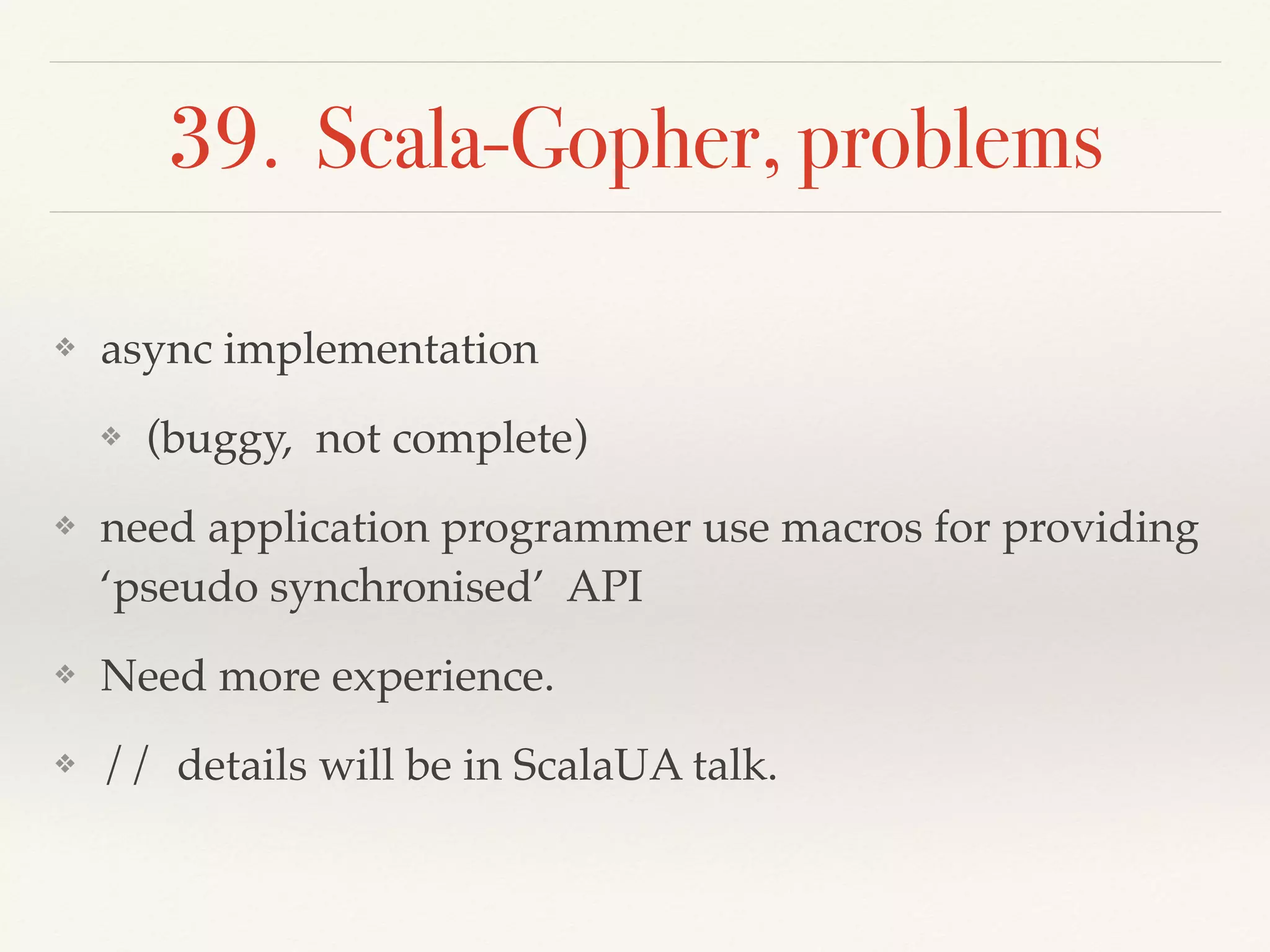This document outlines a presentation about CSP (Communicating Sequential Processes) theory and implementation in Scala using the scala-gopher library. It begins with an introduction to CSP theory, history, and languages like Occam and Limbo that were influenced by it. It then demonstrates how scala-gopher implements key CSP concepts like channels, selectors, and processes in Scala. Examples are shown of writing Fibonacci sequences and broadcasting messages using these primitives. Potential issues with the current scala-gopher implementation are noted.
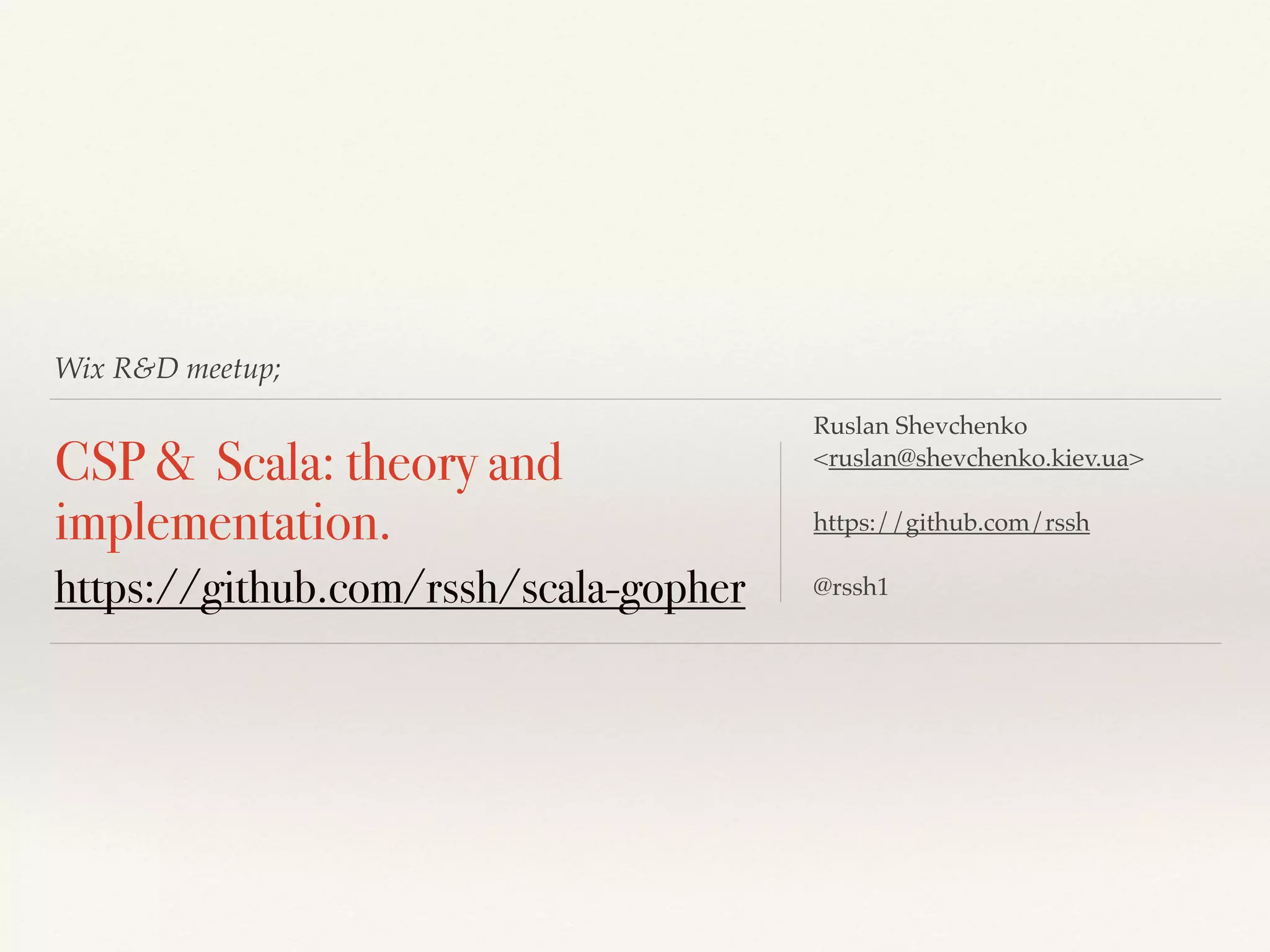
![2. Outline
❖ Theory & History
❖ CSP = Communication Sequence Processes
❖ !-calculus (CCS = Calculus of Communicating System)
❖ Languages: (Occam,Limbo, Go[Clojure, Scala, … ])
❖ Main constructions / idioms, how they looks
❖ Channels, Selectors, Transputers
❖ Implementation Techniques](https://image.slidesharecdn.com/cspscalawixmeetup2016-160317174752/75/Csp-scala-wixmeetup2016-2-2048.jpg)
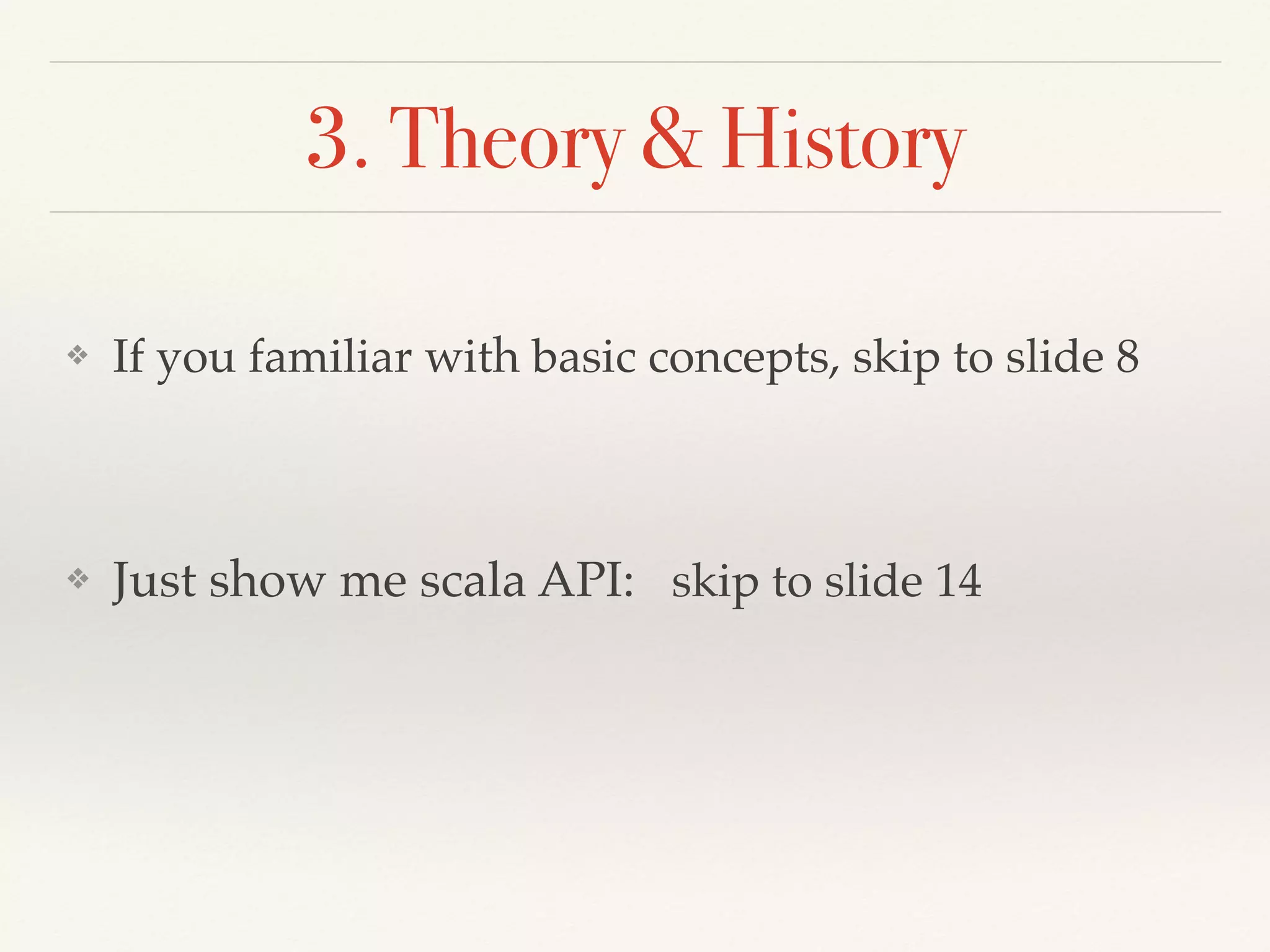
![4. Theory & History
❖ CPS = Communication Sequence Processes.
❖ CSS = Calculus of Communicating System.
❖ 1978 First CSP Paper by Tony Hoar.
❖ 1980. CSS by Robert Milner. (Algebraic Processes)
❖ 1985 CSP formalism (influenced by CSS) in CSP Book
❖ http://www.usingcsp.com/
❖ 1992 !-calculus [CSS + Channels] (Robert Milner, Joachim Parrow,
David Walker)
❖ …. (large family of Process Algebras, including Actor Model, ACP, )](https://image.slidesharecdn.com/cspscalawixmeetup2016-160317174752/75/Csp-scala-wixmeetup2016-4-2048.jpg)

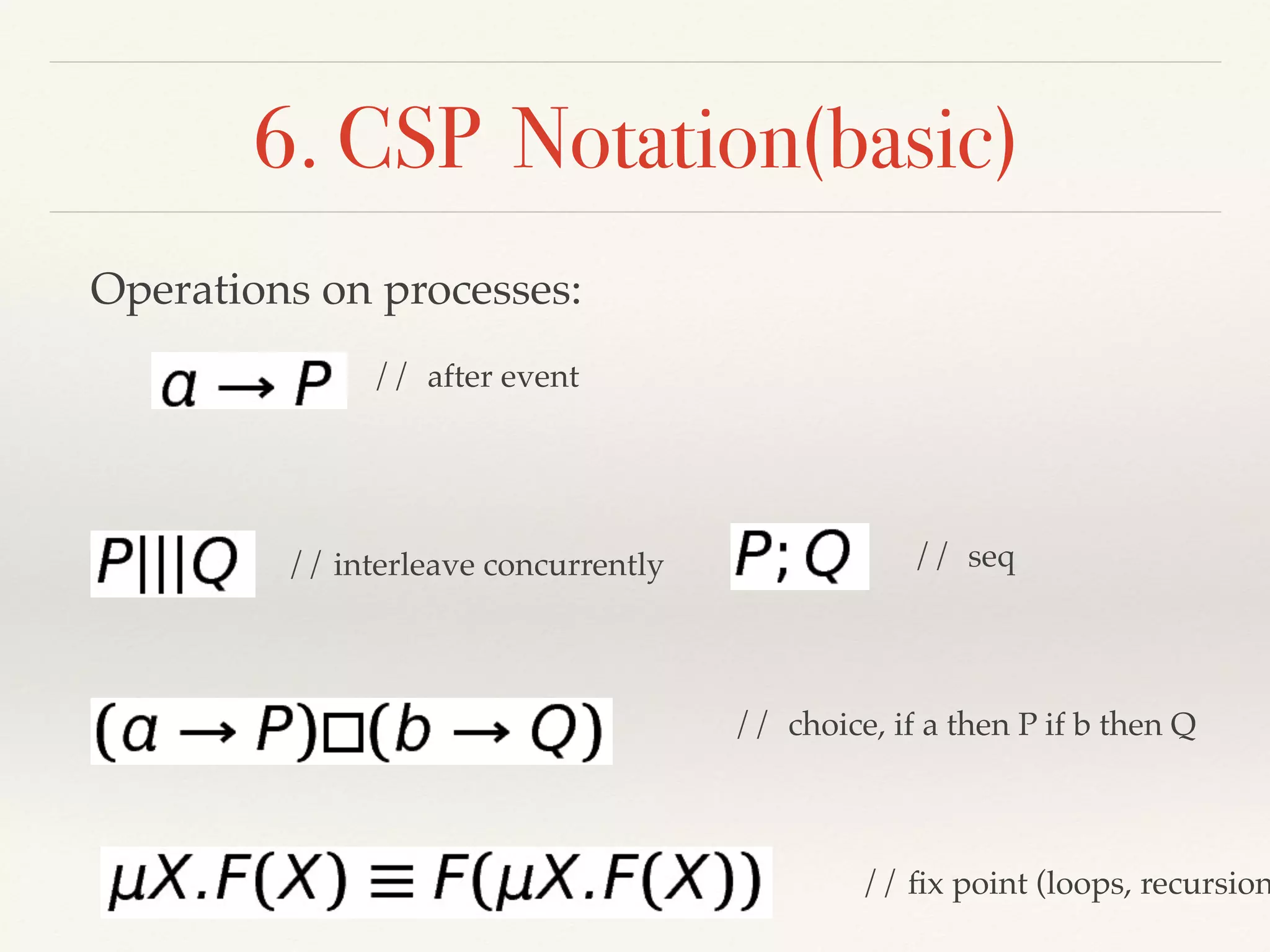


![9. Occam language
❖ created by INMOS
❖ targeted Transputers CHIP architecture (bare metal)
❖ latest dialect: occam-! [1996]
❖ extensions from !-calculus
❖ (more dynamic, channels can be send via channels)
❖ http://concurrency.cc — occam for Aurdino.](https://image.slidesharecdn.com/cspscalawixmeetup2016-160317174752/75/Csp-scala-wixmeetup2016-9-2048.jpg)
![10. Inferno, Limbo, Go
❖ Unix, Plan9, Inferno: [At&t; Bell labs; vita nuova]
❖ http://www.vitanuova.com/inferno/
❖ Limbo … C-like language + channels + buffered channels.
❖ Go … channels as in Limbo (Go roots is from hell is not a metaphor)
Sean Forward
David Leo Presotto
Rob Pike
Dennis M. Ritchie
Ken Thompson](https://image.slidesharecdn.com/cspscalawixmeetup2016-160317174752/75/Csp-scala-wixmeetup2016-10-2048.jpg)
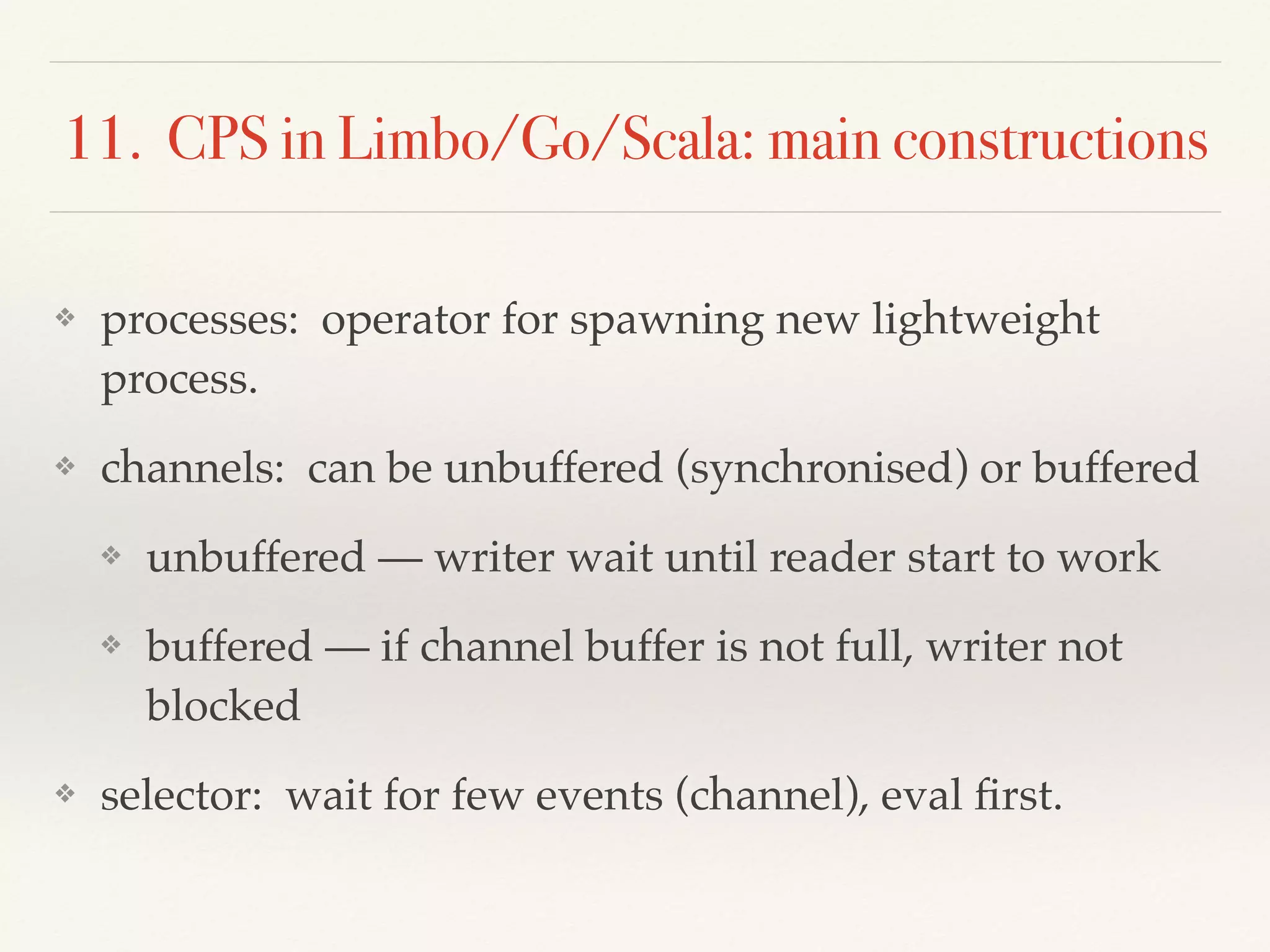
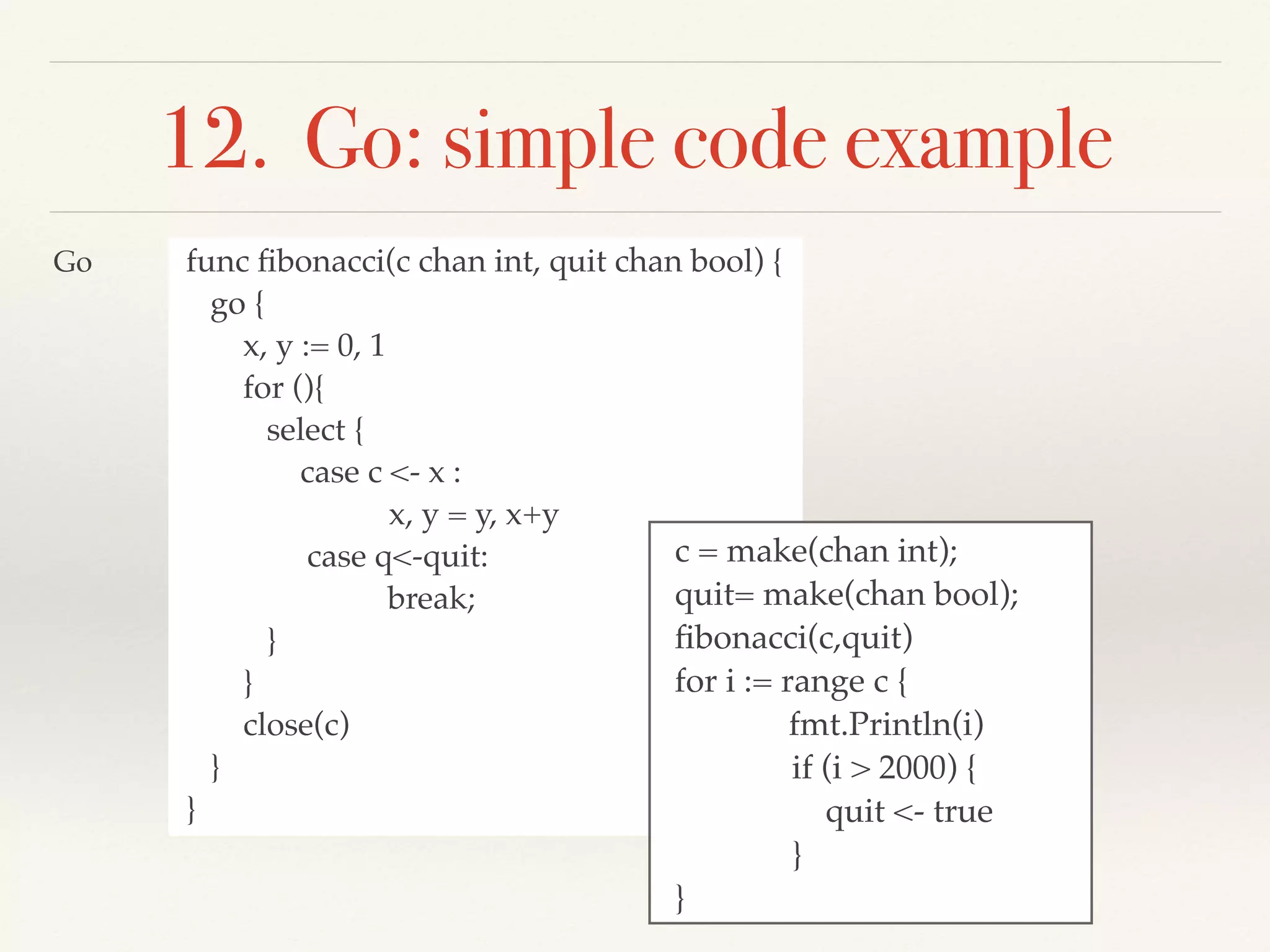
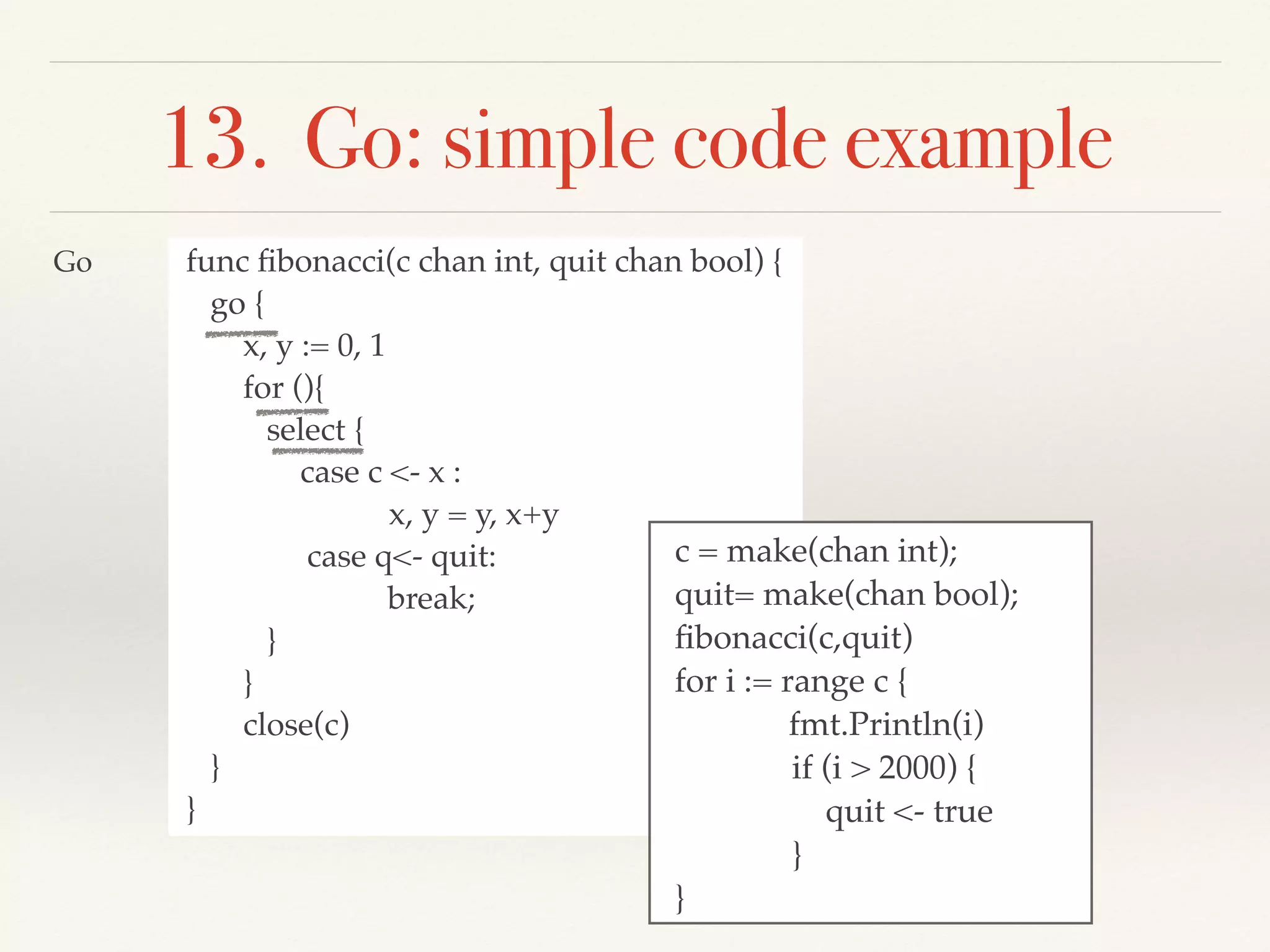
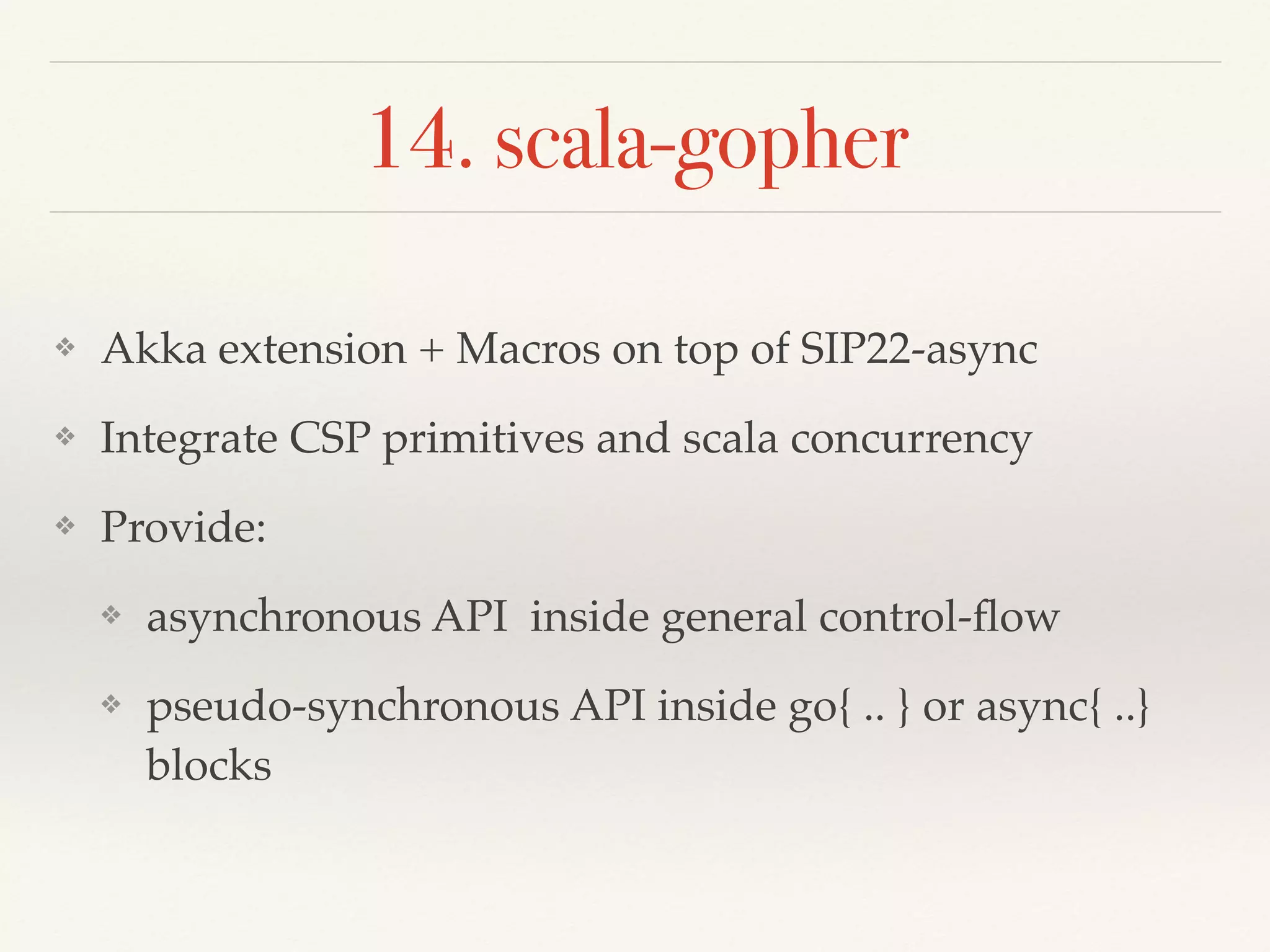
![def fibonacci(c: Channel[Int], quit: Channel[Boolean]): Future[Unit] = go {
var (x, y) = (0, 1)
select.forever{
case x : c.write =>
val z = x
x = y; y = x+z
case q: quit.read =>
CurrentFlowTermination.exit(())
}
c.close()
}
15. Scala: simple code example (direct translation)
val c = makeChannel[Int]()
val quit= makeChannel[Boolean]();
val f = fibonacci(c,quit)
for ( i <- c) {
System.out.print(i)
if (i > N) {
quit.awrite( true )
Scala](https://image.slidesharecdn.com/cspscalawixmeetup2016-160317174752/75/Csp-scala-wixmeetup2016-15-2048.jpg)
: Future[T]
❖ inside body we can use pseudosynchronous API
❖ defer
❖ select [forever, once] => [choice]
❖ case matching macros; for statement, fold, ..
❖ channels
❖ channels/ Input[X]/Output[X] / collection API
val gopherApi = GopherAPI(actorsSystem)
import gopherApi._](https://image.slidesharecdn.com/cspscalawixmeetup2016-160317174752/75/Csp-scala-wixmeetup2016-16-2048.jpg)
![def fibonacci(c: Channel[Int], quit: Channel[Boolean]): Future[Unit] = go {
var (x, y) = (0, 1)
select.forever{
case x : c.write =>
val z = x
x = y; y = x+z
case q: quit.read =>
CurrentFlowTermination.exit(())
}
c.close()
}
}
17. Scala: simple code example (direct translation)
val c = makeChannel[Int]()
val quit= makeChannel[Boolean]();
val f = fibonacci(c,quit)
for ( i <- c) {
System.out.print(i)
if (i > N) {
quit.awrite( true )
Scala
(mutable var, WTF ?)](https://image.slidesharecdn.com/cspscalawixmeetup2016-160317174752/75/Csp-scala-wixmeetup2016-17-2048.jpg)
![def fibonacci(c: Channel[Int], quit: Channel[Boolean]): Future[Unit] = go {
select.fold((0,1)){ case ((x,y),s) =>
s match {
case x : c.write =>
(y, x+y)
case q: quit.read =>
CurrentFlowTermination.exit((x,y))
}
}
c.close()
}
18. Scala: simple code example (fold)
val c = makeChannel[Int]()
val quit= makeChannel[Boolean]();
val f = fibonacci(c,quit)
for ( i <- c) {
System.out.print(i)
if (i > N) {
quit.awrite( true )
Scala](https://image.slidesharecdn.com/cspscalawixmeetup2016-160317174752/75/Csp-scala-wixmeetup2016-18-2048.jpg)
![def fibonacci(c: Channel[Int], quit: Channel[Boolean]): Future[Unit] = go {
val (x,y) = select.fold((0,1)){ case ((x,y),s) =>
s match {
case x : c.write =>
(y, x+y)
case q: quit.read =>
CurrentFlowTermination.exit((x,y))
}
}
c.close()
}
19. Scala: simple code example (fold)
val c = makeChannel[Int]()
val quit= makeChannel[Boolean]();
val f = fibonacci(c,quit)
for ( i <- c) {
System.out.print(i)
if (i > N) {
quit.awrite( true )
Scala](https://image.slidesharecdn.com/cspscalawixmeetup2016-160317174752/75/Csp-scala-wixmeetup2016-19-2048.jpg)
![def fibonacci(c: Channel[Int], quit: Channel[Boolean]): Future[(Int,Int)] =
select.afold((0,1)){ case ((x,y),s) =>
s match {
case x : c.write =>
(y, x+y)
case q: quit.read =>
c.close()
CurrentFlowTermination.exit((x,y))
}
}
20. Scala: simple code example (аfold)
val c = makeChannel[Int]()
val quit= makeChannel[Boolean]();
val f = fibonacci(c,quit)
for ( i <- c) {
System.out.print(i)
if (i > N) {
quit.awrite( true )
Scala](https://image.slidesharecdn.com/cspscalawixmeetup2016-160317174752/75/Csp-scala-wixmeetup2016-20-2048.jpg)
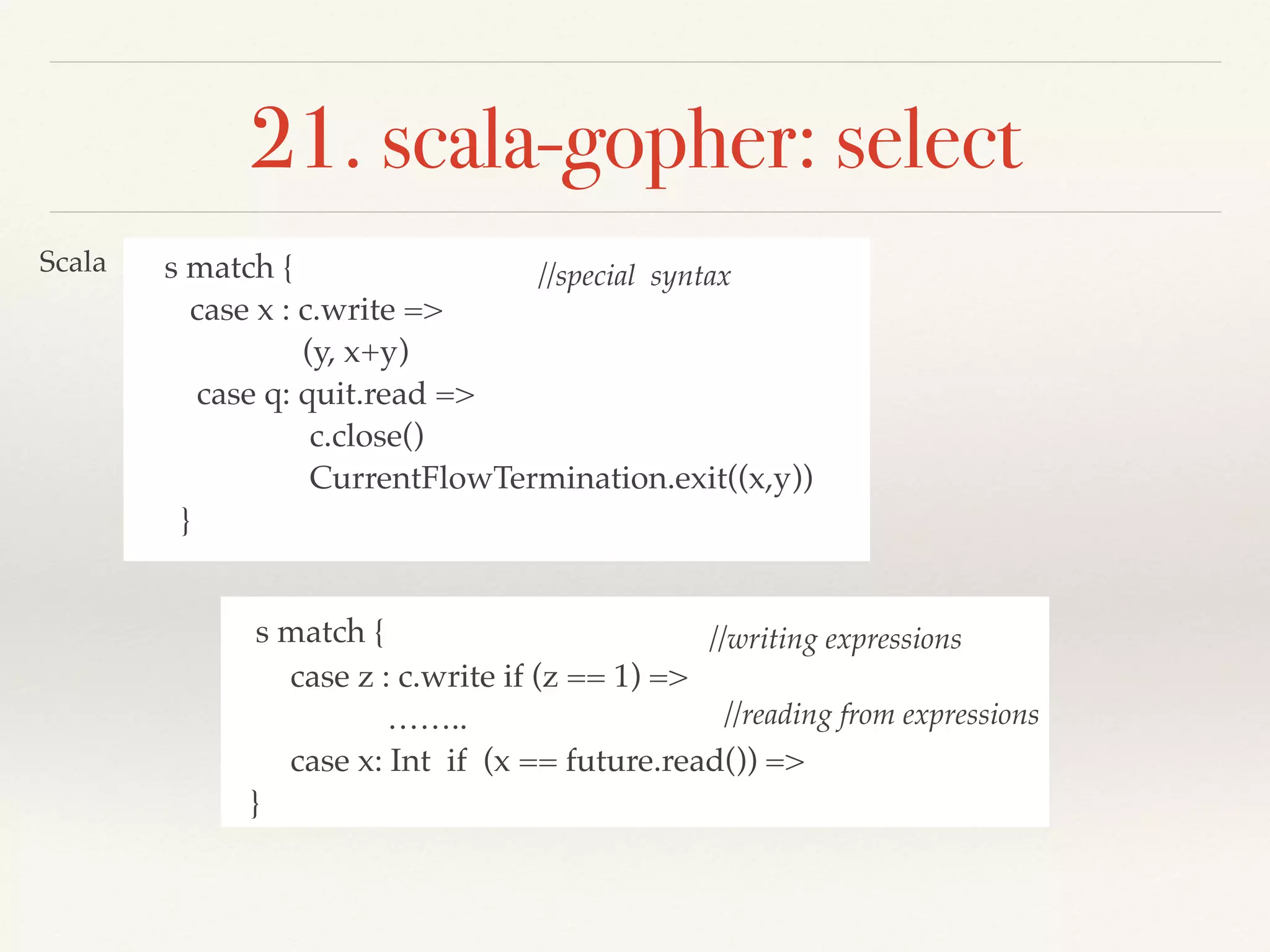


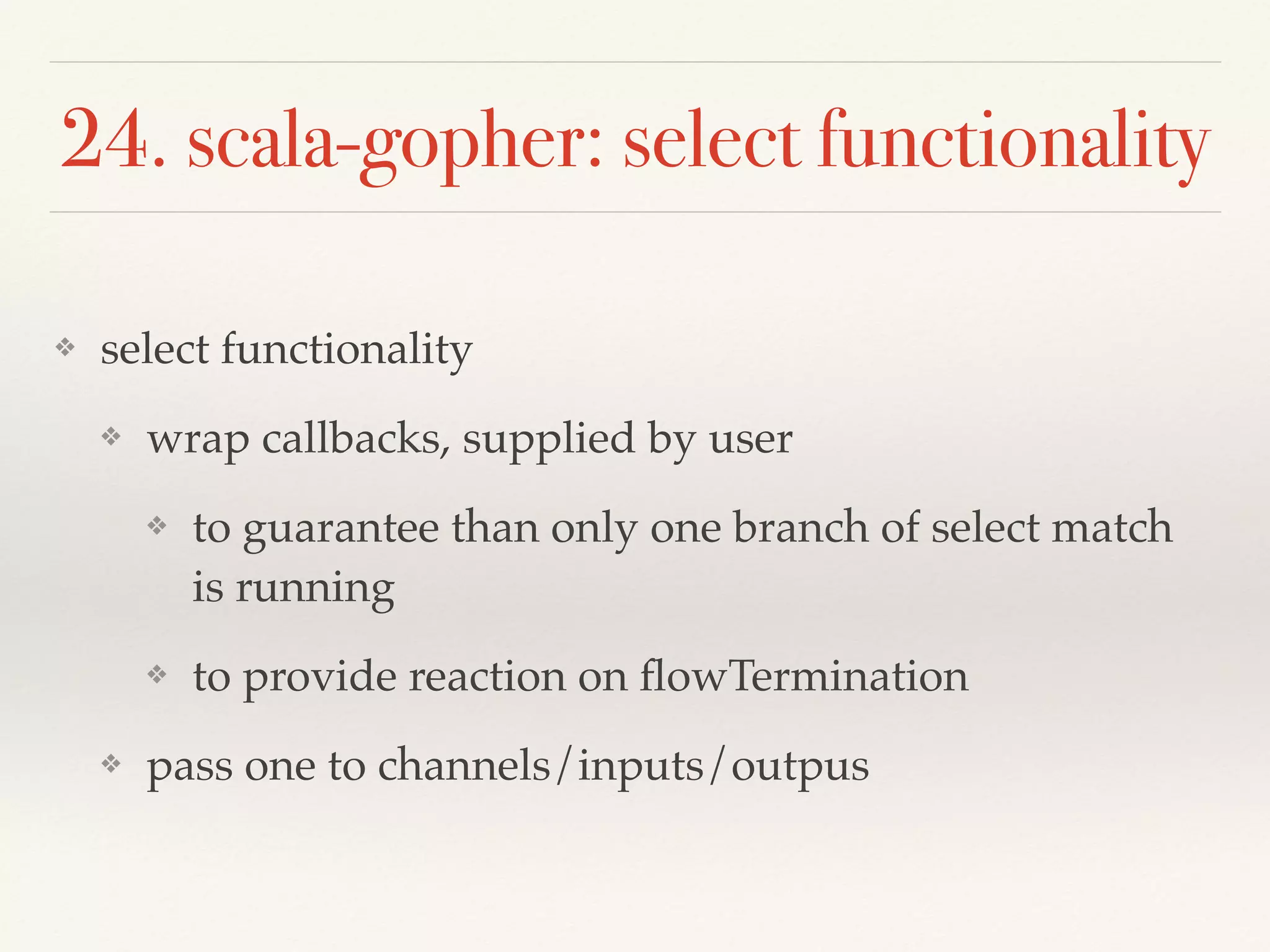
![25. scala-gopher: Input/Output.
❖ Input[T] - something, from which we can wait input
❖ callback-based ‘native’ trait.
❖ implementations: channels, futures, collections …
❖ collection-like methods: map, filter, fold, zip,
append, merge…
aread(): Future[T]
read: T = await(aread)
<~ = read.](https://image.slidesharecdn.com/cspscalawixmeetup2016-160317174752/75/Csp-scala-wixmeetup2016-25-2048.jpg)
![26. scala-gopher: Input/Output.
❖ Output[T] - something, where we can send value
❖ callback-based ‘native’ trait.
❖ implementations: channels, promises, actor-s…
awrite(v:T): Future[T]
write(t): T = await(awrite(t))
~> = write.](https://image.slidesharecdn.com/cspscalawixmeetup2016-160317174752/75/Csp-scala-wixmeetup2016-26-2048.jpg)



class Receiver[V](initChannel: Message, handle: V => Unit)
{
val current = makeEffectedChannel(initChannel)
val future = current.forever{ message =>
current write message.value
current := message.nextChannel
go { handle(message.value) }
}
}](https://image.slidesharecdn.com/cspscalawixmeetup2016-160317174752/75/Csp-scala-wixmeetup2016-29-2048.jpg)
![30. Example: broadcast without listener registry
class Broadcaster[V]() // single-threaded
{
var last = makeNextChannel
def send(v: V) : Unit = {
val next = makeNextChannel
last write Message(v, next)
last = next
}
def makeReceiver(handler: V => Unit) =
new Receiver(current, next)
def makeNextChannel = makeChannel[Message[V]](1)
}](https://image.slidesharecdn.com/cspscalawixmeetup2016-160317174752/75/Csp-scala-wixmeetup2016-30-2048.jpg)
![31. Example: broadcast without listener registry
class Broadcaster[V]()
{
val sendc = makeChannel[V]()
val requestLast = makeChannel[Channel[Channel[Value[V]]]()
val future = select.fold(makeNextChannel){ (last,s) =>
s match {
case v:sendc.read => val next = makeNextChannel
last <~ Message(v,next)
next
case r:requestLast.read =>
r <~ last
last
}
}
def send(v: V) : Unit = sendc.send(v)](https://image.slidesharecdn.com/cspscalawixmeetup2016-160317174752/75/Csp-scala-wixmeetup2016-31-2048.jpg)
![31. Example: broadcast without listener registry
class Broadcaster[V]()
{
val sendc = makeChannel[V]()
val requestLast = makeChannel[Channel[Channel[Value[V]]]()
val future = select.fold(makeNextChannel){ (last,s) =>
s match {
case v:sendc.read => val next = makeNextChannel
last <~ Message(v,next)
next
case r:requestLast.read =>
r <~ last
last
}
}
def makeReceiver(handler): Future[Receiver] = go {
val r = makeChannel[Channel[Message[V]]
requestLast <- r
Receiver(await(r.read),handler)](https://image.slidesharecdn.com/cspscalawixmeetup2016-160317174752/75/Csp-scala-wixmeetup2016-32-2048.jpg)
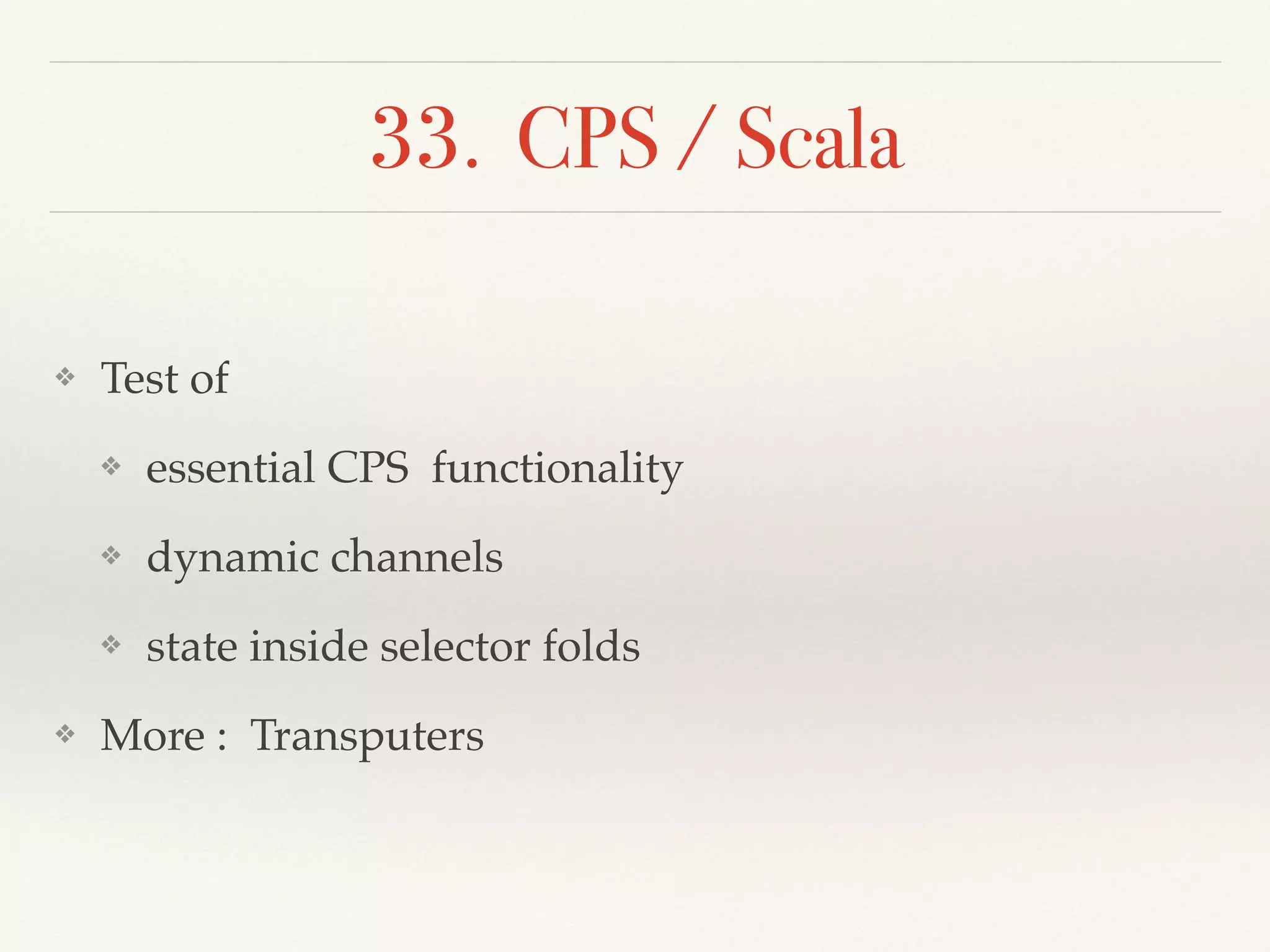
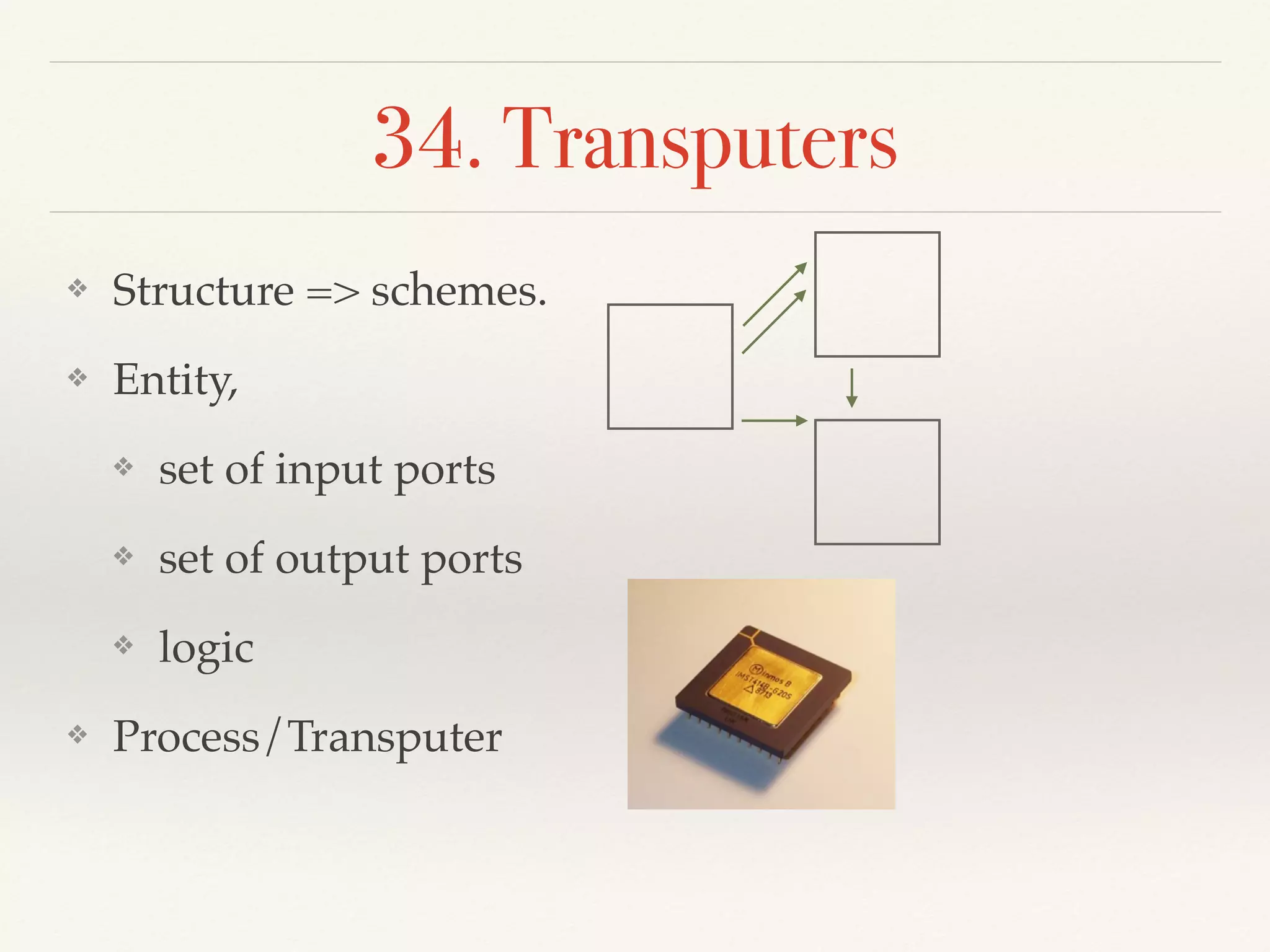
![35 Transputers.
trait Bingo extends Transputer
{
val inX = inPort[Int]()
val inY = inPort[Int]()
val out = OutPort[String]()
loop {
case x: inX.read =>
val y = inY.read
if (x == y) {
out <~ “Bingo!”
}
}
}](https://image.slidesharecdn.com/cspscalawixmeetup2016-160317174752/75/Csp-scala-wixmeetup2016-35-2048.jpg)
![36. Transputers
❖ like actors, but for channels
❖ can be supervised ‘as actors’.
❖ can be connected to each other
val (inX,inY) = (makeChannel[Int](), makeChannel[Int])
val bing = makeTransputer[Bingo]
val acceptor = makeTransputer[Acceptor]
bingo.inX connect inX
bingo.inY connect inY
bingo.out connect acceptor
(bingo + acceptor).start()](https://image.slidesharecdn.com/cspscalawixmeetup2016-160317174752/75/Csp-scala-wixmeetup2016-36-2048.jpg)

![38. Scala concurrency ecosystem
❖ Future [?]
❖ Erlang-Style ? (actors)
❖ Ozz-Style ? (async [partially])
❖ CPS (gopher)
❖ Rx [?]
❖ Can be used together.](https://image.slidesharecdn.com/cspscalawixmeetup2016-160317174752/75/Csp-scala-wixmeetup2016-38-2048.jpg)
